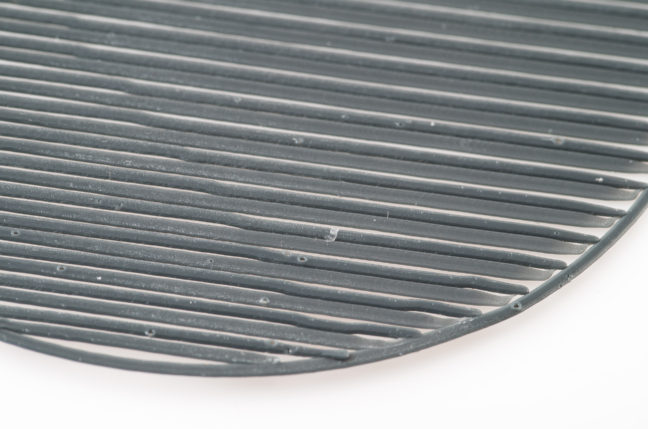I’ve heard many times over that to test backlash in a printer you can grab it by the nozzle and wiggle it around (with the nozzle cold of course, but with the motors powered up). Ideally nothing moves, but when I tried that with my Tiko there was a disconcerting amount of motion. The motion came primarily from two sources, the motor mounts and the flexible delta rods. The movement from the rods at least offered up a bit of resistance so I expect those to be only an issue at higher speeds, but the movement in the motor mounts offered almost no resistance.
I assume this is the source of many of the unexpected motion I sometimes see from my Tiko, the jumping to the side when moving the nozzle up and down, the shifting when trying to print a straight line. You can see some of the shifts in the raft print above, the nozzle will be printing a straight line and it will shift to the side. Interestingly you can also see some craters in the filament, that’s what happens when you don’t store your filament properly and it absorbs moisture (I’ve mostly been testing unspooled leftover filament that wasn’t stored properly). I store all of my open filament spools in watertight bins and with rechargeable desiccant, but you can read more about that here,
Tensioner Clips
I posted the clips I used to attach the motor mounts more securely to the rails on Thingiverse. If you do use them I’d recommend printing them in PETG, though I think ABS will work too. PLA clips will probably work for a while, but the amount of tension will change over time and I don’t expect they’ll be useful for more than a couple of days (due to creep). I’ve usually find PETG the most reliable for this type of application. (Makes me wonder if creep is the reason these clips are so far out of tolerance to begin with, I have a hard time imagining they were design like this or that they warped that far out of spec.)
Installation
The small clips are easy to use, you can clip them on to the motor mount without disassembling anything. The large clips require some disassembly, and I’m not sure it’s worth the trouble, It doesn’t seem much different using 6 clips vs 3. Be careful with the amount of tension, if it’s too tight, there will be too much friction and the motors will start skipping steps. If they’re too loose, it will probably be harmless, but it might not help much either.
After installing the most of the wobble in the system should be gone, and the motion of the hotend should be much smoother. It makes manual calibration easier as the nozzle actually move a semi-consistent amount every time you hit the arrow (I still have to hit it a million times though, because of my [custom build plates](http://www.thingiverse.com/thing:2042445)).
Testing
I haven’t had enough time to test as I’d like but the result are promising so far. It isn’t just being able to print straight lines, I think it may also be helping with the layer shifts since the nozzle is less likely to crash into the print if it can move on a plane reliably.
Other Solutions
Also check out the Tiko Forums for other solutions that may be more effective. I’ve seen a bunch of other ideas there and some people are getting good results with their Tikos. Want to try your own fix, feel free to start from my Onshape design files if that helps.


